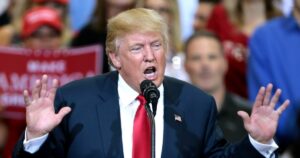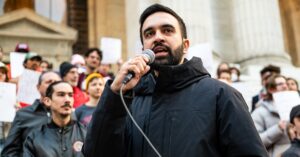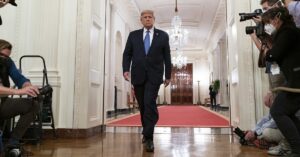Trump seeks Supreme Court approval for Chicago National Guard deployment
Hold onto your hats, folks—President Trump is taking his fight for law and order straight to the Supreme Court, pushing to deploy the National Guard in Chicago despite fierce pushback from local leaders, The Hill reported.
The crux of this showdown is Trump’s bid to send military forces into Democratic strongholds like Chicago, a move blocked by a judge’s ruling but now under urgent appeal to the nation’s highest court.
This saga kicked off with the Trump administration’s plan to station National Guard troops in cities such as Los Angeles, Portland, Washington, D.C., and now Chicago, citing a need to bolster federal authority. It’s no secret that these areas lean heavily left, and the president argues that local governance has failed to maintain control. Let’s just say, the welcome mat isn’t exactly rolled out for federal boots on the ground.
Legal Battles Heat Up Over Deployment
Before the Supreme Court got involved, a district judge, April Perry, slapped down Trump’s plan on October 9 with an injunction, halting the deployment of hundreds of National Guard members to Illinois. About 300 Illinois troops and 200 from Texas were already in the Chicago area for a 60-day stint, though U.S. Northern Command insists they’re just twiddling their thumbs, “not conducting any operational activities at this time.”
Local heavyweights, including Governor JB Pritzker, aren’t mincing words, branding this federal push as an “unconstitutional invasion of Illinois by the federal government.” That’s a spicy take, but one wonders if state leaders are more concerned with optics than with addressing the underlying issues Trump claims to target.
Not to be outdone, Illinois Attorney General Kwame Raoul is doubling down, promising to “vigorously” oppose the administration’s efforts in court. He’s echoing the lower courts’ stance that there’s simply no justification for troops in the state. It’s a classic state-versus-federal power clash, with Illinois digging in its heels.
Supreme Court Steps Into the Fray
Fast forward to Friday, when the Justice Department, led by Solicitor General D. John Sauer, filed an emergency plea to the Supreme Court to pause the district court’s block. Sauer argues that federal agents enforcing immigration laws are facing “prolonged, coordinated, violent resistance,” a claim that paints a dire picture of the streets. But are we talking full-blown chaos or just a few loud protests stretched for dramatic effect?
“This Court should stay the district court’s October 9 injunction in its entirety,” Sauer wrote in the administration’s request to the justices. “The injunction improperly impinges on the President’s authority and needlessly endangers federal personnel and property.”
Now, Sauer’s narrative of violent resistance is being challenged by local leaders who insist recent protests in Chicago have been small and mostly peaceful. If true, this undercuts the urgency of Trump’s call for military backup. One has to ask: Is this about safety, or scoring political points in blue cities?
Appeals and Opposition Mount Quickly
The Supreme Court isn’t wasting time, requesting a response from Illinois and Chicago officials by Monday evening to weigh in on the administration’s arguments. Meanwhile, the U.S. Court of Appeals for the 7th Circuit already shot down Trump’s request just a day before the Supreme Court appeal, finding “insufficient evidence” of rebellion or law enforcement failure to justify troops. That’s two strikes from the judiciary—will the highest court swing differently?
The 7th Circuit panel did acknowledge Trump’s control over the National Guard but concluded the situation in Illinois doesn’t warrant such drastic measures. Even with deference to the president’s claims, the judges weren’t convinced. It’s a polite but firm reminder that executive power isn’t a blank check.
Back in Chicago, the legal wrangling continues as Judge Perry’s ruling blocking Trump’s troop control remains paused pending the appeal’s outcome. This leaves the situation in limbo, with troops on the ground but not active. Talk about a bureaucratic standoff—everyone’s waiting for the next move.
Broader Implications for Federal Power
Let’s zoom out: This isn’t just about Chicago—it’s the first time the Supreme Court has been asked to rule on Trump’s use of the National Guard domestically. The precedent here could reshape how federal and state powers collide, especially in politically charged environments. If Trump wins, expect more military presence in cities; if he loses, state resistance might only grow bolder.
Sauer’s filing also points to a “disturbing and recurring pattern” of local leaders suing the federal government and courts issuing injunctions, often sidelining the safety of federal agents. While that sounds alarming, one could argue it’s just democracy at work—checks and balances aren’t always convenient for those in power. Still, the administration’s frustration is palpable, and they’re not wrong to demand clarity on protecting their personnel.
At the end of the day, this clash encapsulates a deeper divide: federal authority versus state sovereignty, law enforcement versus local governance. Trump’s push for the National Guard in Chicago isn’t just a policy debate; it’s a test of how far presidential power can stretch in the face of progressive opposition. As the Supreme Court deliberates, the nation watches—because wherever this lands, it’s bound to ripple far beyond Illinois.




